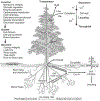Mechanisms of nitrogen deposition effects on temperate forest lichens and trees
- PMID: 34327038
- PMCID: PMC8318115
- DOI: 10.1002/ecs2.1717
Mechanisms of nitrogen deposition effects on temperate forest lichens and trees
Abstract
We review the mechanisms of deleterious nitrogen (N) deposition impacts on temperate forests, with a particular focus on trees and lichens. Elevated anthropogenic N deposition to forests has varied effects on individual organisms depending on characteristics both of the N inputs (form, timing, amount) and of the organisms (ecology, physiology) involved. Improved mechanistic knowledge of these effects can aid in developing robust predictions of how organisms respond to either increases or decreases in N deposition. Rising N levels affect forests in micro- and macroscopic ways from physiological responses at the cellular, tissue, and organism levels to influencing individual species and entire communities and ecosystems. A synthesis of these processes forms the basis for the overarching themes of this paper, which focuses on N effects at different levels of biological organization in temperate forests. For lichens, the mechanisms of direct effects of N are relatively well known at cellular, organismal, and community levels, though interactions of N with other stressors merit further research. For trees, effects of N deposition are better understood for N as an acidifying agent than as a nutrient; in both cases, the impacts can reflect direct effects on short time scales and indirect effects mediated through long-term soil and belowground changes. There are many gaps on fundamental N use and cycling in ecosystems, and we highlight the most critical gaps for understanding potential deleterious effects of N deposition. For lichens, these gaps include both how N affects specific metabolic pathways and how N is metabolized. For trees, these gaps include understanding the direct effects of N deposition onto forest canopies, the sensitivity of different tree species and mycorrhizal symbionts to N, the influence of soil properties, and the reversibility of N and acidification effects on plants and soils. Continued study of how these N response mechanisms interact with one another, and with other dimensions of global change, remains essential for predicting ongoing changes in lichen and tree populations across North American temperate forests.
Keywords: acidification; eutrophication; forests; lichens; mechanism of effect; nitrogen deposition; trees.
Figures


References
-
- Aber J, McDowell W, Nadelhoffer K, Magill A, Berntson G, Kamakea M, McNulty S, Currie W, Rustad L, and Fernandez I. 1998. Nitrogen saturation in temperate forest ecosystems. BioScience 48:921–934.
-
- Arneth A, et al. 2010. Terrestrial biogeochemical feedbacks in the climate system. Nature Geoscience 3:525–532.
-
- Bal TL, Storer AJ, Jurgensen MF, Doskey PV, and Amacher MC. 2015. Nutrient stress predisposes and contributes to sugar maple dieback across its northern range: a review. Forestry 88:64–83.
-
- Bassin S, Volk M, Suter M, Buchmann N, and Fuhrer J. 2007. Nitrogen deposition but not ozone affects productivity and community composition of subalpine grassland after 3 yr of treatment. New Phytologist 175:523–534. - PubMed
-
- Bassin S, Werner RA, Sörgel K, Volk M, Buchmann N, and Fuhrer J. 2009. Effects of combined ozone and nitrogen deposition on the in situ properties of eleven key plant species of a subalpine pasture. Oecologia 158:747–756. - PubMed
Grants and funding
LinkOut - more resources
Full Text Sources
